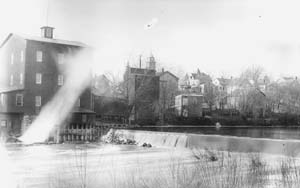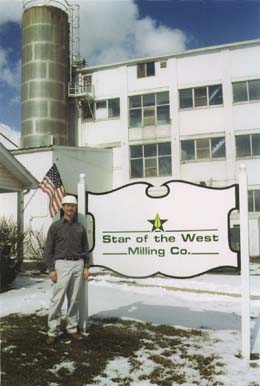
Normally unobtrusive - remarkably so, for an operating flour mill in the center of a small rural village - the Star of the West Milling Company has made the news lately with plans to build eight towering grain silos at its South Main Street site in the village of Churchville. Some residents here feel this addition will alter the look and character of the village. At the least, they say it will shift the focal point of the village to the mill. At the most, they fear it will affect their property values adversely. Other community members, along with farmers from across the region, point out that the mill was here first. Some, including Village Historian Ron Belczak, say it is precisely the mill’s historical ability to adapt and improve with the times which has allowed Churchville’s oldest business to quietly thrive for 192 years. Churchville’s first business According to Belczak, Church found the wheat growing locally to be far superior to that grown in his native Massachusetts, and he began shipping some of the high-quality flour he produced back home. By 1815, drawn by the rich farm land, others began to settle here and build homes in what is now the village. "Many people exchanged land in Massachusetts, which was hilly and rocky, for land here," said Belczak. "Here was virgin territory and the land was excellent for growing. … The wheat industry drove the settlement." Other flour mills began to spring up, and in the 1830s 10 mills operated in Monroe County. By 1860, 24 mills operated along the Genesee River, and another 10 operated between Chili and Churchville. Flour milling was a major industry and Rochester became known as the "The Flour City." The abundance and quality of the wheat grown in this area made area mills successful, but it was the willingness of the owners of the Churchville mill to roll with the changes that allowed it to survive. It is the only remaining flour mill in Monroe County; one of only six mills left in New York state. It was George Harmon who made the first major technological change to the mill when he bought it from Church around 1884. He added steam power, meaning the mill could now operate independently of the flow of Black Creek. Harmon sold the mill to Charles Sage and Frank Potter in 1887, and it burned to the ground in March 1888. Sage and Potter rebuilt immediately and the mill reopened on the same site in October of 1888 - producing 15,000 pounds of flour per day. Around the beginning of the twentieth century, Sage and Potter purchased land on South Main Street to take advantage of the railroad, which had come into the village in 1837, according to Belczak. In 1914, Potter and a new partner built a state-of-the-art facility on the site with a gas generator to power the mill. They also replaced millstones, which ground the entire kernel of wheat into flour, with rollers and sifters. This basic process, still used today, separates the bran, middlings, wheat germ and endosperm, producing a much higher quality flour, according to Star of the West Manager Francois Lachance. Through several ownership changes over the next century, the mill continued to improve technologies and increase production, but the plant built in 1914 is still the same basic facility in operation today. The mill was operated from 1946 to 1965 by a farm cooperative called GLF. The cooperative purchased the mill to secure an outlet for the wheat their farmer members were growing in this area, Lachance said. In 1965, GLF merged with two other farm cooperatives, Pennsylvania Farm Bureau and Eastern States, to form Agway, which continued to operate the mill until 2000. Agway updated the mill by installing pneumatics to convey the flour, replacing the old bucket elevator system, and converting the business from a bag flour to a bulk flour facility. In May 2000, Agway sold the mill to its current owner, the Star of the West Milling Company, based in Frankenmuth, Michigan. Except for the seven months it took to rebuild the mill after the fire of 1888, and a couple of years when Samuel Church closed it to fight in the War of 1812, the Churchville flour mill has operated continuously for 192 years.
The Churchville Chamber of Commerce has named Lachance, the mill’s current manager, its 2002 Businessperson of the Year. This honor is awarded to an individual who has had a positive impact on the community through business, but Lachance says the honor should go to the mill itself. "I think it’s an honor, but the honor goes to the business," Lachance said. "It’s a good business here, a successful, important part of the community." Over the past three years, the Village of Churchville has seen three of its major businesses close their doors, and several others struggle to remain open. Meanwhile, Star of the West has managed a 50 percent increase in production. "There aren’t too many businesses that can say that," said Lachance. "Especially in a business as basic as food." Lachance says the quality product the mill provides, being aggressive in what he calls a very competitive market, and the mill’s location, are the keys to its success. "Most companies are not located as nearby their product source," he said. The proximity of wheat grown in the area, and a large East Coast customer base, help Star of the West succeed selling a product with a relatively low profit margin. "Flour is a commodity, not an expensive one, so you can’t ship it far. The freight would kill you," Lachance said. Star of the West produces more than 75 million pounds of flour and 30 million pounds of animal feed per year. The mill runs 24 hours per day, six days per week, employing 14 people. As far as industry goes, this one is amazingly gentle to the environment, according to Lachance. "We have one raw ingredient we bring into the mill: wheat, that’s it," he said. The mill does not discharge anything into the village’s sewer system - any water used in the process ends up in the flour. The mill also creates no waste. The best part of the wheat kernel is made into flour. The bran is sold to cereal companies, and whatever is leftover is made into animal feed. "(In the cleaning process) we take out dust, chaff etceteras, and it is ground up and mixed with the animal feed. We bring in two million pounds of (raw material) and use it all," Lachance said. According to Lachance, the wheat grown in New York state is called "soft winter wheat." There are three types of wheat grown in the United States: soft wheat, used in pastries and cakes; hard wheat, used in breads and rolls; and durum wheat, which is used for pasta. This year, Lachance said his mill will purchase more than two million bushels of wheat from local farmers - 25 percent of the state’s wheat crop. Most of the pastry and cake flour Star of the West produces is shipped in bulk tanker trucks to commercial customers on the East Coast, such as Dunkin’ Donuts and Freihofer. "If you eat a Dunkin’ Donut anywhere east of the Mississippi, you are eating a donut made with flour manufactured right here in Churchville," Lachance says. Forging a new partnership The mill now has storage capacity for 250,000 bushels of wheat, a six-week supply, while the current industry standard is a six-month supply, according to Lachance. "Six weeks’ worth is not sufficient," he told Churchville Zoning Board of Appeals members at a public hearing last month, where he was requesting the height variance necessary to build the silos. (The mill is located in an industrial-zoned area with a 50-foot height restriction.) "It is very difficult to operate under those circumstances," he said. "We can’t buy wheat at harvest." To get the best prices on wheat, the mill must be able to purchase more when prices are at their lowest. Getting the best price is necessary to be competitive in an industry where fewer and fewer mills remain. In addition to keeping up with current production, Star of the West plans to expand the mill, adding storage for the finished product as well. "We have customers that would like to buy from us that we can’t supply," he said. Over the next 10-15 years, Star of the Mill hopes to see production double. While Lachance stated his need for the variance, neighbors asked the Zoning Board of Appeals to stick to the 50-foot requirement and have the mill build shorter, wider silos, or add a storage facility outside the village. Area farmers came from miles to support the mill, knowing their survival as small farmers could depend on it. The vote is expected March 13. As board members ponder the variance request, Star of the West owners are left to ponder the mill’s role in the community - forced to realize how important community support can be. Lachance said he is aware that the flour mill has not been active in the community, and in fact, some residents pass it daily, unsure of what it even is. "At my first chamber of commerce meeting here I sat next to a woman who said ‘I’ve lived here my whole life and never knew what you do over there!’" Lachance said. How is it that a business with such a large physical presence in the community can have such a small impact on its people’s lives? What role should a business take supporting the community that it has been a part of for so long? "In the past, erroneously, the company … always asked what benefit (would community involvement have) for us?" Lachance admits. He said the policy of previous owners seems to have been "Stay below the radar, don’t make waves, just keep doing what we do, running a profitable business." "I think now, as part of Star of the West, they’re very civic minded," he said. "The people, the employees are very involved," he said, referring to the mill in the company’s home village of Frankenmuth. "That mill is very important to that town. I see with the Star of the West the philosophy is more getting involved with the community." In a village as small as Churchville, great potential exists for the Star of the West to have a huge impact on its community. This area is rooted in agriculture, and Lachance agreed many events, such as the Churchville Lions Club’s Annual Country Fair, seem like a great match for sponsorship and participation by an industry like the flour mill. It is up to the residents and the village’s municipal government now to decide if, and how, they want to support this business - and to what extent they want construction impacting their daily lives and the landscape of their quaint village. At the same time, Star of the West owners and manager must plan their future in the community. Should they simply loom over the village center, quietly milling flour, or should the mill become an active part of, a leader in, the community? Does a business have a social responsibility to the community in which it operates? Whether or not Churchville’s flour mill will continue to grow and thrive, whether or not it will achieve the role of prominence and influence in the community it enjoyed in the days of Samuel Church, the past 192 years have been a testament to the role of adaptation in survival. "As long as people keep eating, there will always be a demand for our products," Lachance told Churchville Chamber of Commerce members last month. "We just have to make sure we keep up with technologies as our owners have for the two centuries." |



